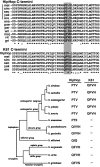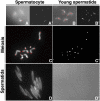Paternal imprint essential for the inheritance of telomere identity in Drosophila
- PMID: 21383184
- PMCID: PMC3064339
- DOI: 10.1073/pnas.1016792108
Paternal imprint essential for the inheritance of telomere identity in Drosophila
Abstract
Chromatin remodeling during sperm maturation could erase epigenetic landmarks on the paternal genome, creating a challenge for its reestablishment on fertilization. Here, we show that selective retention of a chromosomal protein in mature sperm protects the identity of paternal telomeres in Drosophila. The ms(3)k81 (k81) gene is a duplication of hiphop that encodes a telomeric protein. Although HipHop protects telomeres in somatic cells, K81 is produced exclusively in males and localizes to telomeres in postmitotic cells, including mature sperm. In embryos fathered by k81 mutants, the maternal supplies fail to reestablish a protective cap on paternal telomeres, leading to their fusions. These fusions hinder the segregation of the paternal genome and result in haploid embryos with maternal chromosomes. The functional divergence between hiphop and k81 manifests not only in their expression patterns but also in the protein functions that they encode. By swapping the two coding regions, we show that K81 can replace HipHop for somatic protection; however, HipHop cannot replace K81 in the germ line to specify telomere identity, because HipHop ectopically expressed in the testis is removed from chromatin during sperm maturation. HipHop lacks a short motif in K81 that is essential for K81 to survive the remodeling process. We show that the combined functions of HipHop and K81 are likely fulfilled by the single ancestral hiphop locus in other Drosophila species, supporting the hypothesis that the evolutionary process of subfunctionalization was responsible for the preservation of the hiphop-k81 duplicate.
Conflict of interest statement
The authors declare no conflict of interest.
Figures






References
-
- Miller D, Brinkworth M, Iles D. Paternal DNA packaging in spermatozoa: More than the sum of its parts? DNA, histones, protamines and epigenetics. Reproduction. 2010;139:287–301. - PubMed
-
- Palmer DK, O'Day K, Margolis RL. The centromere specific histone CENP-A is selectively retained in discrete foci in mammalian sperm nuclei. Chromosoma. 1990;100:32–36. - PubMed
Publication types
MeSH terms
Substances
Grants and funding
LinkOut - more resources
Full Text Sources
Molecular Biology Databases
Miscellaneous

